2012 VOLKSWAGEN GOLF PLUS fuel cap
[x] Cancel search: fuel capPage 15 of 541
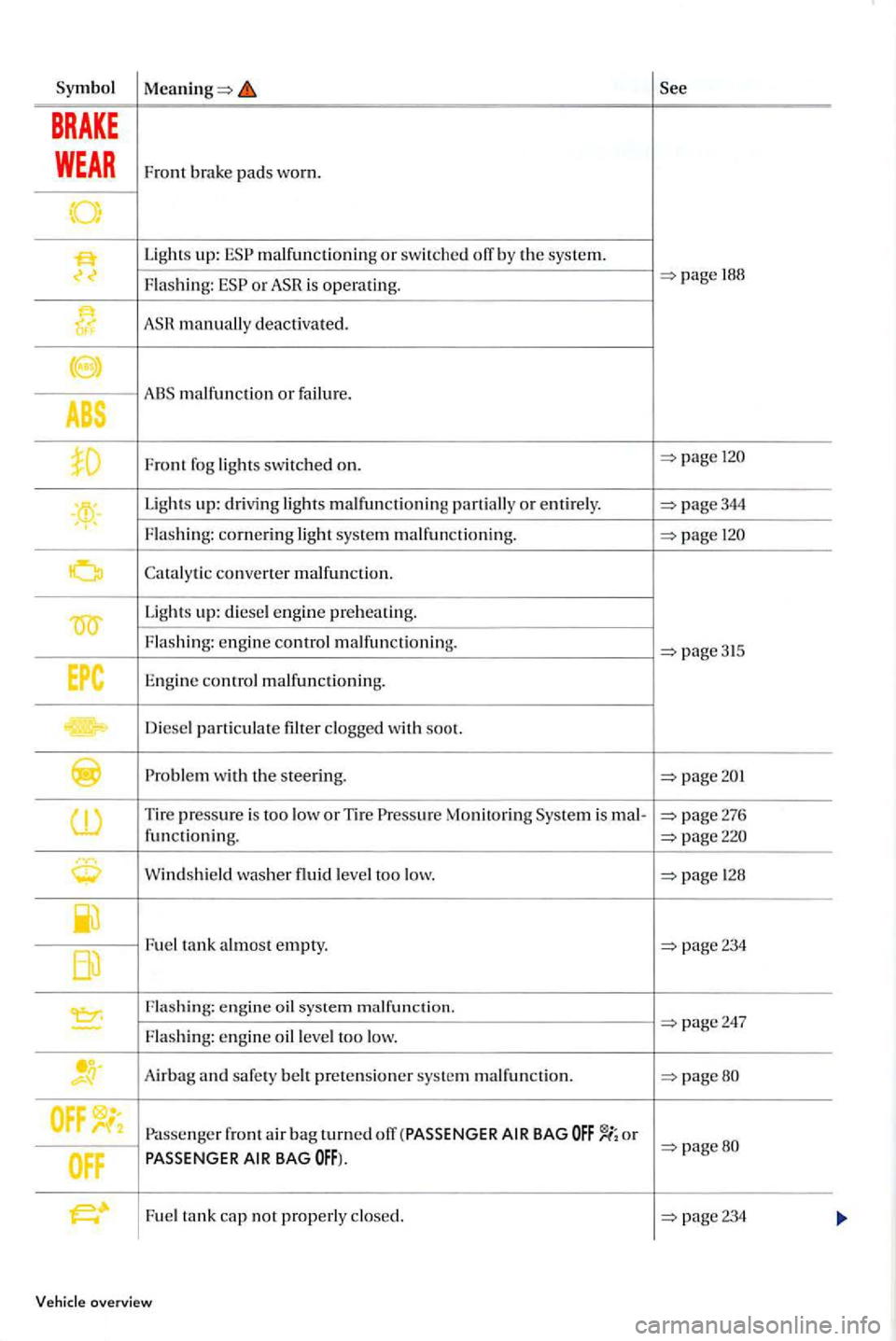
Symbol
BRAKE
WEAR Fro nt brake pads wo rn.
Lights up: malfuncti oning or sw itched o!T b y th e system.
Flashing: or 188
manually deactivated.
malfunction or fail ure.
Fr ont fog lights switch ed on.
Ligh ts up: driving lights m alfunctioning parti ally or en tirely . page344 ! Flashing: cornerin g light system malfun ctionin g. 120
converter malfunction.
Lig ht s up: die sel eng in e preheati ng.
F l
ashi ng: en gin e contro l malfunctio ning. page315
Engine control malfunctionin g.
D i
esel p a rt ic u la te filt er clogged with soot.
with the s teering.
Tir e pressure is too low or Tire Monitoring Syste m is page276
fun ctioning.
Wind shi eld was he r fluid level too low. 1 28
F u e l tank a lmost empty. page234
Fla sh ing: engin e oil system malfunct io n. page247 -Fla sh in g: en gin e oil level too low.
A irba g and safety belt pretensio ne r sys te m malfunction. page80
Passenger front air bag turned o!T o r page80
Fuel t an k cap not properly c losed.
overview
Page 231 of 541
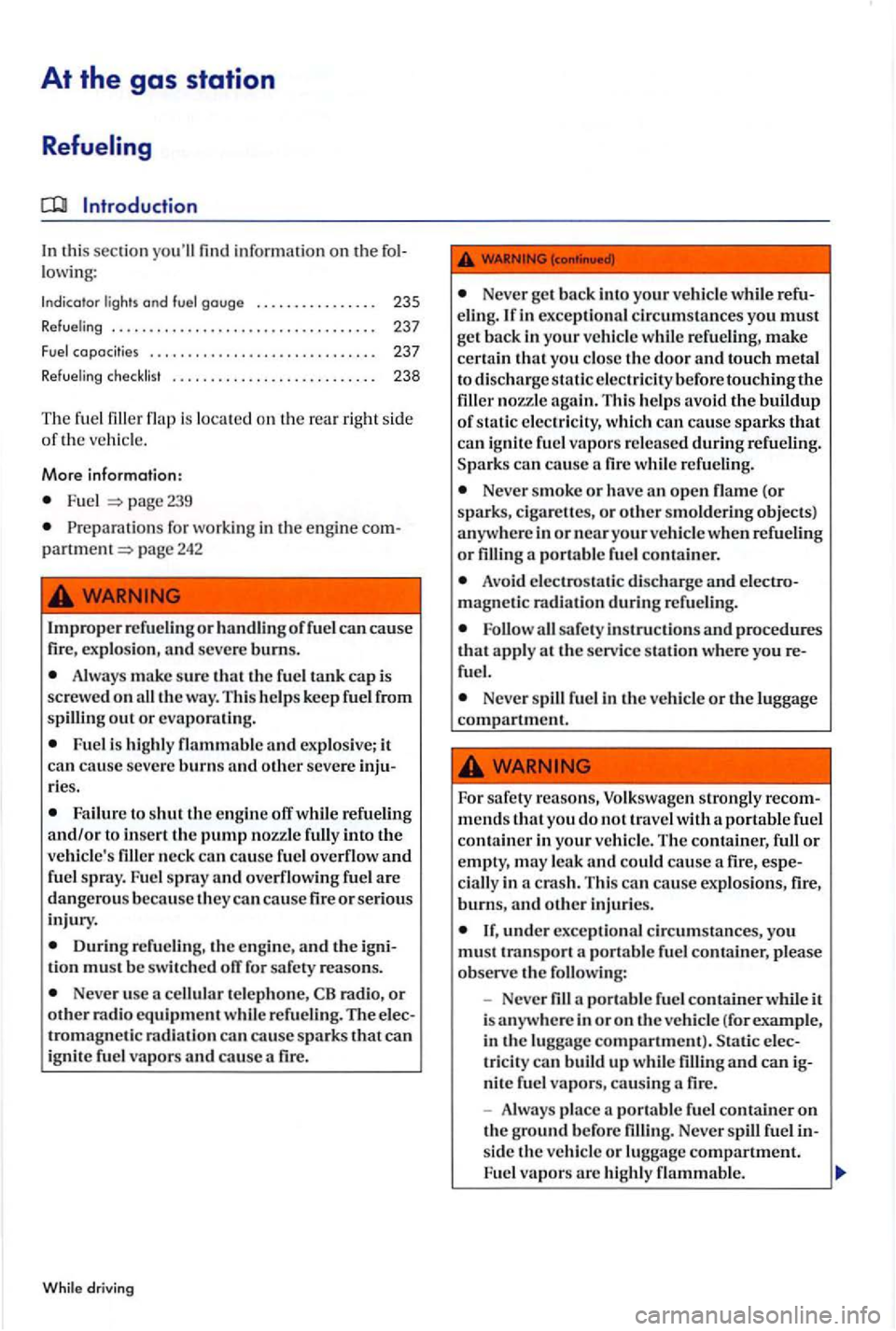
At the gas station
Refueling
In this section yo u'll fin d information on the lowing:
Indicator lights and gouge . . . . . . . . . . . . . . . . 235
Refueling . . . . . . . . . . . . . . . . . . . . . . . . . . .
. . . . . . . . . 237
Refueling checklist . . . . . . . . . . . . . . . . . . . . . . . . . 238
The fue l filler flap is located on the rear ri ght side of th e ve hicle.
More info rmation:
Fuel page 239
Preparations for work ing in the engine page 242
Improp er refuel in g or ha ndl in g of fue l can ca use fire, explosion, an d severe burns.
Always m ake sure that the fuel tank cap is
screwed on all the way. This help s keep fu el from spillin g out or evapora ting.
Fuel is highly flammable and explosive ; it can cause severe burns and other seve re ries.
Failure to shut the e ngine off while refueling and/or to in se rt the pump nozz le into the vehicl e's filler n eck can cause fu e l overflow and fue l spray. Fuel spray and overflowing fuel are dangerous beca use they can ca use fire or seriou s
injury.
Durin g refuelin g, the e ngine, an d th e ti on must be swi tc hed off for safety reasons.
Never use a cell ular te leph one, radio, or other radio eq uipment while refueli ng. The
fire.
While driving
Neve r get back into your veh icle while eling . If in exce ptiona l circumstan ces you must
ge t back in your ve hicl e while refue ling, make cert ain that you close th e door and touch metal
to disc harge static electricity before touching the filler nozzle again. This helps avoid the buildup of stati c elec tricity , w hich can cause sparks that can ig nit e fuel vapors re leased during refueling .
Never smoke or have an open flam e (or
sparks, ciga re tt es, or oth er sm old erin g obj ects)
anywhere in or your vehicle when refueling
o r
Avoid elec trostatic discharge and
safety instructions and procedures that apply a t th e service statio n whe re yo u fuel.
Never spill fuel in the ve hicl e or the luggage compartment.
For safety
or empty, may leak and could cause a fire,
under exce ption al cir cumstances, yo u must tmnspo rt a po rt able fuel contain er, please observe the following:
- Neve r
fill a portable fuel container while it
i s anywhere in or o n the ve hicl e (for example,
i n the luggage compartment). tri city ca n build up while filling and can
Page 233 of 541
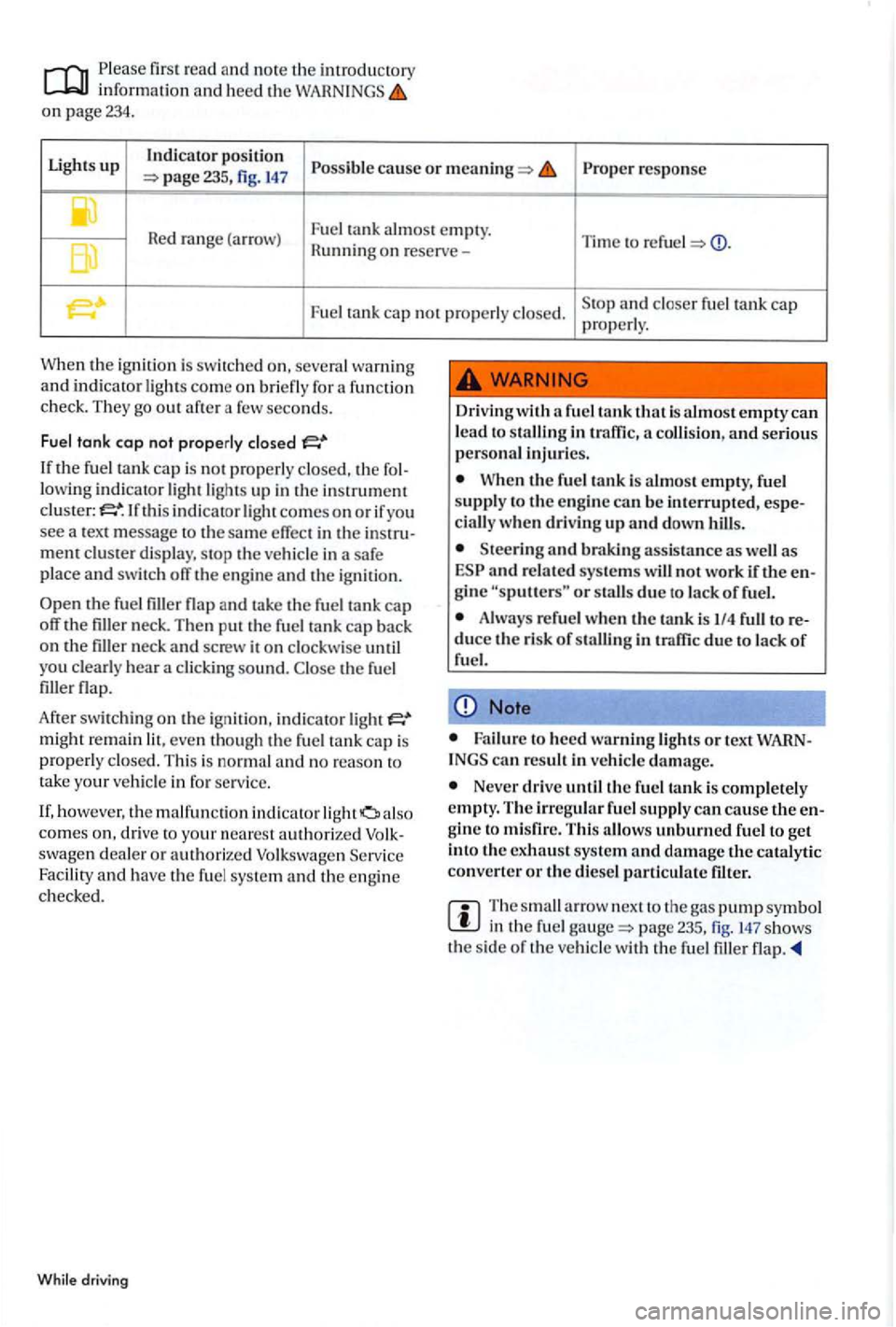
information and heed the WAHNINGS on page 234.
Lights
up Indicator pos itio n response 235, fig. 147
Hunning on reserve-
Fu el tank cap not pro perly closed. properly.
When the ignition is switched
a few seconds.
Fuel tank cap not properly
indicator ligh t comes on or if yo u see a tex t m essage to the same effec t in the in strument clu ste r d is play , stop the ve hicl e in a safe
p lace and switch ofT the en g ine and the ig n ition.
might remain even tho ugh the fu el t ank cap is properl y closed. This is no rm al and n o re ason to take your vehicl e in for se rvic e.
however, th e m alfun ctio n indicator light driv e to yo ur neares t authorized swagen dealer or authorize d Volkswage n Serv ice Facility and have fuel sys tem and the engine checked.
While driving
Driving with a fu el tank that is almost empty can
lead t o s tallin g in traffic, a co llisio n, and seriou s
p ersonal injuries.
W hen the fu el t ank is almost empty, fuel
supply to the engine can b e interrupted, especiall y w he n driving up and d ow n hill s.
Steerin g and braking assist ance a s we ll as and re lated syste ms w ill not work if the en
gine or s talls due to lack of fuel.
Always refuel w hen the tank is 1/4 full to re duce the risk of sta ll in g in traffic due to lack of fuel.
Note
----------------------~ Failure to heed warning lights or t ext WARN-can result in veh icle damage.
Never drive until the fuel tank i s com ple te ly
empty. The irregula r fu el supply can cause the e ngine to misfire. This allows unburned fuel t o ge t into the exhau st syste m and damage the cata lyti c
co nverter or the diesel p arti culate filt er.
The small next to the gas pump symbol in the fuel page fig. shows
th e sid e of the ve hicl e w ith the fuel filler flap.
Page 234 of 541
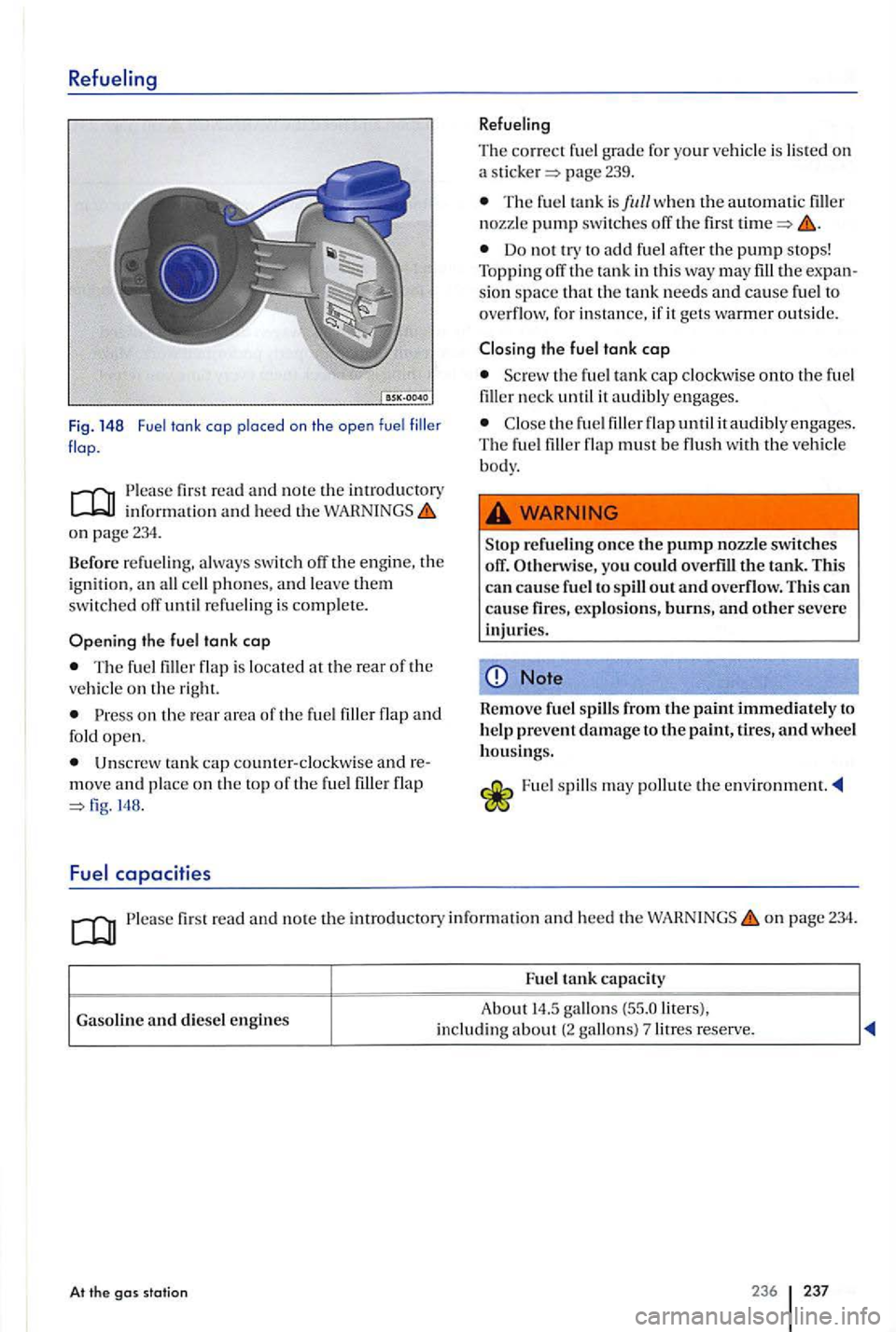
Fig. 148 Fuel tank cap placed on the ope n fue l
Please first read and note the introductory information and heed th e on page 234.
Before refueling, always switch off the eng in e, the
i gnition , a n all cell phones, and leave the m
switc h ed off until refue lin g is complete.
Opening th e fuel tank cop
The fuel filler flap is loca ted at t h e rear of the ve hicl e on the rig ht.
Pr ess on the rear area of th e fu el fille r flap and fo ld open.
flap
capacities
Refueling
Th e correct fu e l grade for your ve hicle is lis te d on a page 239.
The fue l tank is w he n the automatic filler
no zzle pump switche s off the first
Do not t ry to add fu el afte r the pump stops!
Topping off the tank in thi s way may ftll the expan
s ion space that the tank need s and cause fuel to
ov erfl ow, fo r insta nce, if it gets warmer outsid e.
C lo sing the fuel tank cop
onto the fuel filler n eck until it audibl y enga ges.
th e fu el fille r flap until it aud ib ly e nga ges.
T he fuel filler flap must be flu sh with the ve hicle
body.
refu elin g once the pump nozzle switch es
off. you could
Note
Remov e fu el sp ill s from the paint immediately to
h e lp prevent damage to the paint, tires, and wheel hou sing s.
P lease firs t rea d and no te the introduc tory inform ation and heed the on page 234.
F u e l t a
nk capaci ty
A
bout liters ),
i nclud ing about (2 gallons) re se rve . Gaso line and diesel e n g ines
A t th e gas station 236 237
Page 247 of 541
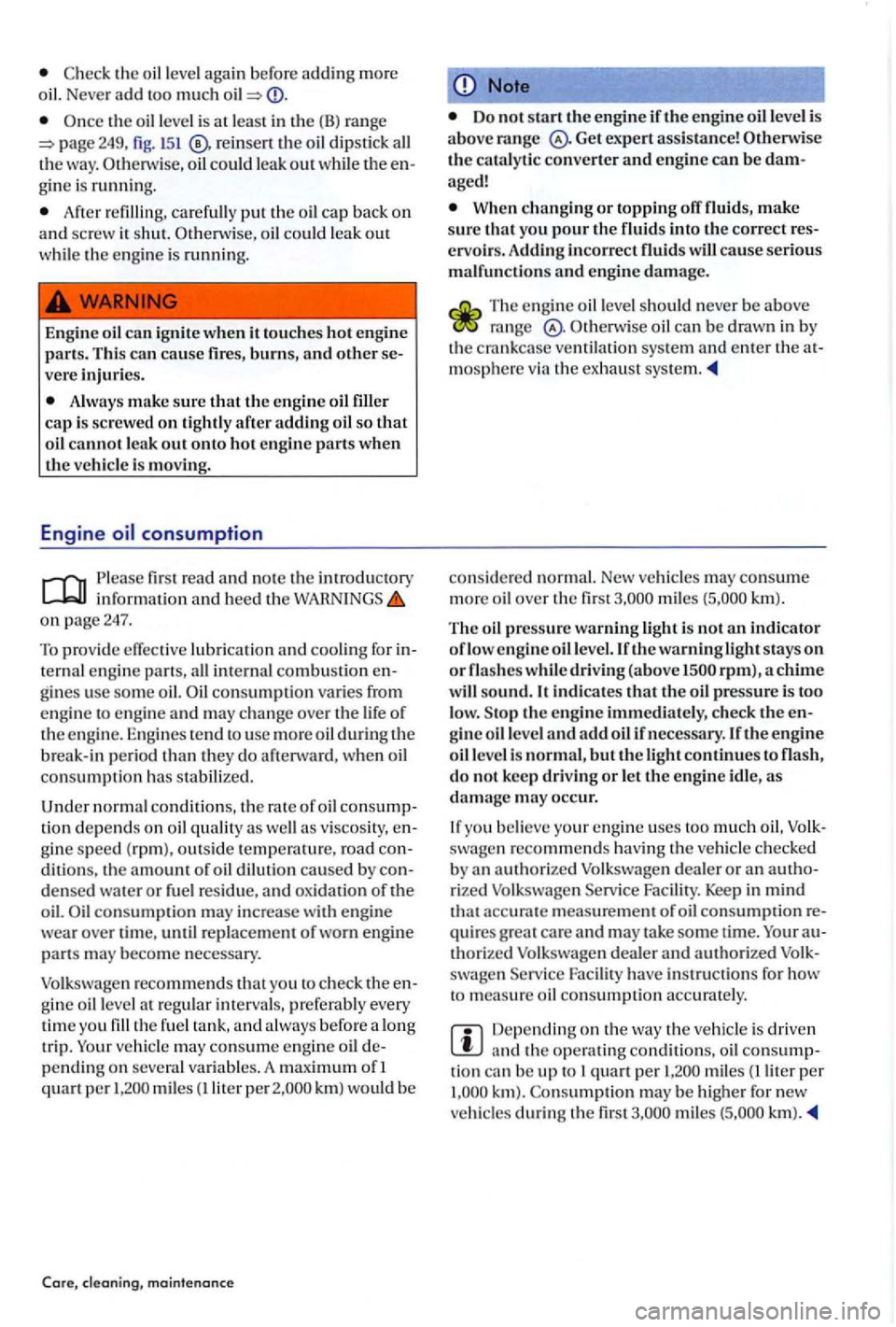
the oil leve l agai n befo re addin g more
oil. Never add much
O nce th e oil leve l is at least in the ( B) ra nge
oil dip stick all th e way. oil could le ak out while th e en
g in e is running.
Afte r r efilling, car efully put the oil ca p back on and scre w it shut. Oth erwi se, oil could leak out whi le th e e ngine is running.
E ngin e oi l ca n ignite
when it tou ches hot e n g ine parts. T hi s can ca use fires, burns, and other severe injuri es.
Always make sure that the engin e oil fill er cap is screwed on tightly afte r adding oil so that oil cannot leak out ont o hot engin e parts whe n
th e vehicle is moving .
Engine
first r ea d and no te th e introductory information and h eed o n pa ge 247.
To prov ide effective lubricatio n and coolin g for in
ternal engine parts, all internal combustio n en
g ines use some oil. consumption varies from
e ng in e to engi ne and may ch an ge ove r th e life of th e e ng in e. Engi nes te nd to use m ore oil during th e
br eak- in peri od th an they do afterwa rd, when oil
co nsumption has s ta bili zed.
rat e of oil consump
tion dep e nd s on oil quality a s well as v isc osity, e n
g in e s pee d (rpm), outs ide tempe rature, road condit io ns, the amount o f oil dilution caused b y condensed water o r fuel residue, and oxidation of th e
o il. consumptio n may in crease with eng in e
wea r ove r time, until re pla cement of worn eng ine part s may beco me necessary .
Volk swage n recommends th at yo u to c heck the engin e oil leve l
vehicl e may consum e engine oil d epending o n seve ral var iables. A maximum of I quart per miles (!lite r km ) would be
Care, maintenance
Note
D o not start the engine if lhe e ngine oil leve l is
above range expert ass is ta n ce! Otl1envise the ca talytic con verter and engine ca n be dam
aged!
W hen changin g or topping ofT make sure that you pour the into the correct reservoir s. Addi ng incorrec t
The e ngine oil leve l s h o uld never be above ran ge oil ca n be drawn in by
th e cra nkcase ventilation syste m and ent er th e at
mo sphere via th e e xh au st sys te m .
co nside red normal. New vehicles may consume
m ore oil over th e km).
T he oi l pressure warning light is not an indicator oflowe ng in e oillevel.lfthe warning light stays on or whil e d rivin g (above rpm), a chime
will sound. It indica tes that the oil pressure is too
low. th e engine immediately, check the engine oil leve l and add oil if n ecessary . If the engine oil leve l is normal , but the continues to do not kee p driving or let t11e e ngin e idl e, as damage may occur.
If you believe your en g in e uses to o much oil, Volkswagen recommends havin g th e vehicle checked b y an auth orized Volkswagen dea le r or an ri ze d Volk swagen Service Facility. Keep in mind that accurate measurem ent of oi l consumption requires great ca re and m ay take som e time. au
t h orized Volkswa gen d ea ler and a uthorized Volk
s wa gen Facility have instru ctions for how to m eas ure oi l co nsumptio n acc ura te ly.
Dep e ndin g on the wa y th e ve hicl e is dri ven an d th e ope ratin g conditions, oil consump
t ion can be up to I quart per mil es (!liter per
Page 292 of 541
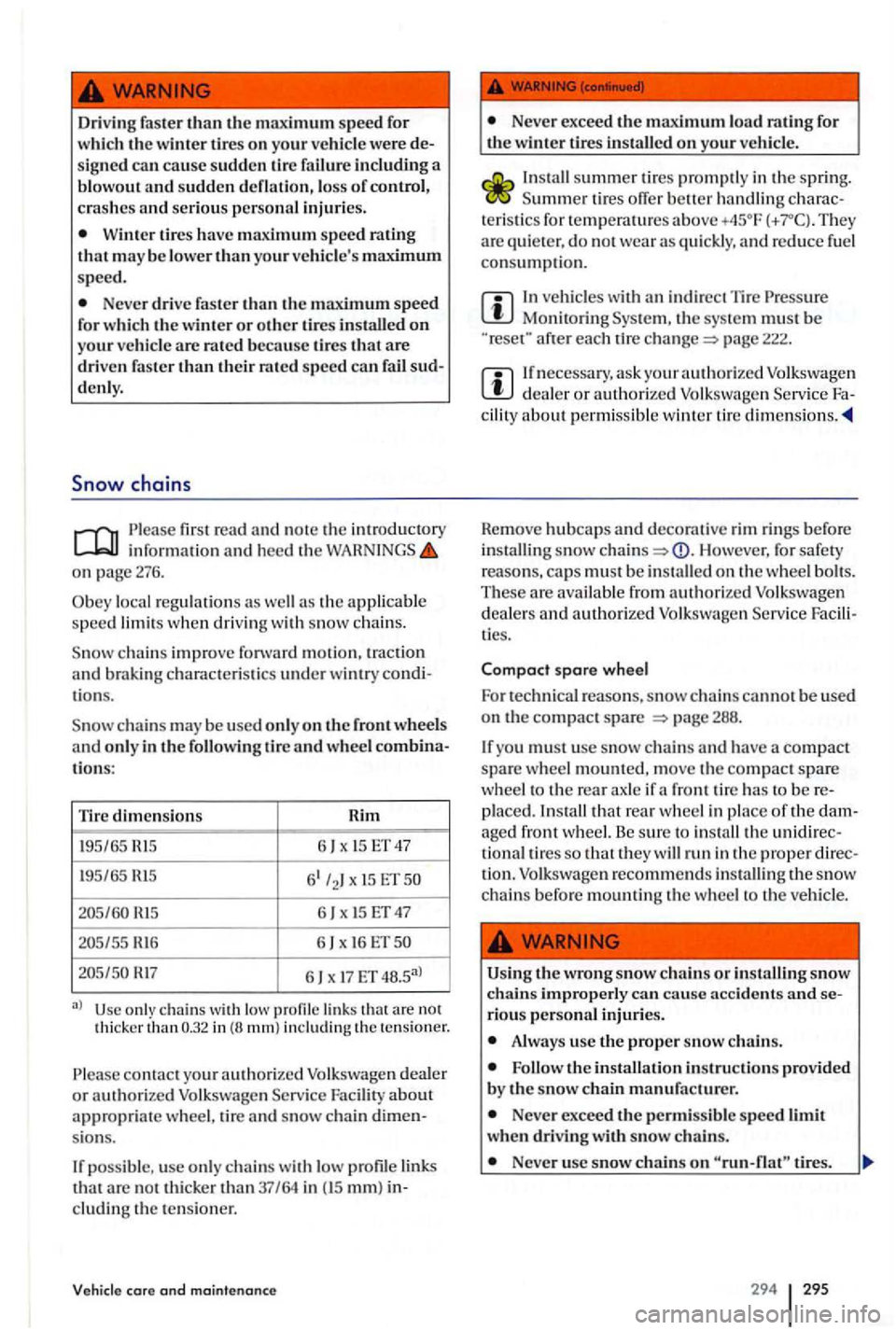
Drivin g faster than the speed fo r
w hich the winter tires on your vehicl e were
serious person al injuries.
Winter tire s have speed be lower your vehicle's maximum speed.
Never drive faster than the s peed fo r w hich the winter or other tires in stalled on your ve hicle are because tires that arc drive n faster than their speed can fail denl y.
Snow chains
first r ead an d n ote the introductory information and heed th e on pagc276.
local re g ul ations as w ell the applicable sp ee d lim its w hen driv in g with snow ch a in s.
wheel tions:
Tire
dimensions Rim
1 9
5/6 5 x 15 ET47
1 9
5/6 5 6 t/2 l x 15 ET5 0
6 x 15 ET 4 7
205/55
x 16 ET50
6 x 17 ET 48.5a l
are not
thic ke r
contact yo ur authorized V olk swage n deal er or authorize d Vo lk swagen s now chain sio ns.
possib le, use o nl y c hain s w ith lo w profile link s that are not thi cke r than37 /64 in mm) cluding th e te n sio ner.
core and maintenance
Never exceed the maximum load for
t h e winter tires install ed on vehicle .
tires offe r be tt er ha ndling teris tics for tcmpe ralll res abo ve T hey are quieter, do not wear as quickly , reduce fuel
cons umption.
In ve hicles with indirect T ir e Monitoring th e sys te m must be each tire page 222.
I f necessa ry , a sk your authorized Volkswagen dealer or authorized Volk swagen
Remove hubcap s and deco rative rim rings before
in sta llin g sno w Ho wever, for safet y
r e a sons, must be in stall ed on th e wheel b o lts. These are ava ilabl e from authorize d Volk swage n
deal ers and authorized Volk swage n ties.
Compact spare w heel
F o r t
echnical r easons, snow ch ain s canno t b e use d
o n the compact spare page 288 .
I f y
ou mus t u se snow chains
front tir e has to be placed. In stall tha t rear w heel in pla ce of the ag ed fron t wheel. Be sure to install the un id ire c
tional tires s o that they will run in the proper tion. Volkswagen recommends in sta lli ng the snow chains be fo re mounting th e wheel to the ve hicl e.
the wrong snow chains or in sta lling snow chains improperly can cause accidents and rious personal injuries.
A lways usc th e proper snow chain s.
the insta llation in structi o ns pro vided by the s now chain manufacturer.
Neve r exceed th e permis si bl e speed lim it when driving with snow ch ains.
Neve r usc snow ch ai ns on tires.
294
295
Page 294 of 541
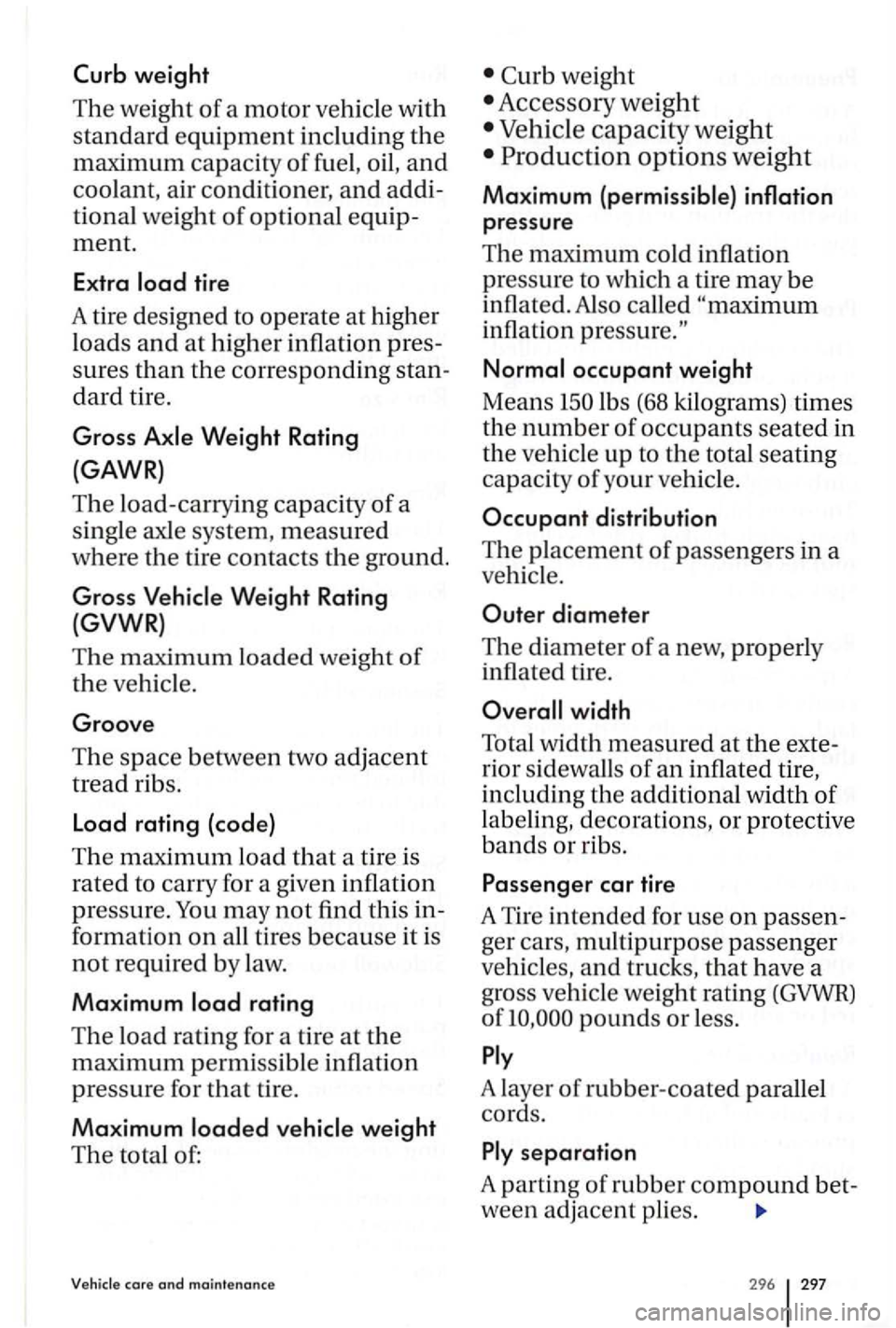
Curb weight
The weight of a motor vehicle with
standard equipment including the
maximum capacity of fuel, oil, and
coolant, air conditioner, and addi
tional weight
of optional equip
ment.
Extra load tire
A tire designed to operate at higher
lo
ads and at higher inflation pres
sures than the corresponding stan
dard tire.
Gross Axle Weight Rating
(GAWR)
The load-carryin g capacity of a
single axle system, measured
where the tire contacts the ground.
Gross
The maximum loaded weight of
the vehicle.
Groove
The space between two adjacent
tread rib s.
Load rating (code)
The maximum load that a tir e is
rated to carry for a given inflation
pressure.
You may not find this in
formation on all tires because it is
not required by law.
Maximum load rating
The load rating for a tire at the
maximum permissible inflation
pressure for
that tire.
Maximum loaded vehicle weight
The total of:
Curb weight
Accessory weight
Vehicle capacity weight
Production options weight
Maximum (permissible) inflation
pressure
The maximum cold inflation
pressure
to whic h a tire may be
inflated.
Also ca lled
inflation
Normal occupant weight
Means 150 lbs (68 kilograms) times
the number of occupants seated in
the veh icle
up to the total seating
capacity
of your vehicle.
Occupant distribution
The placement of passengers in a
veh icle.
pounds or less.
Ply
A layer of rubber- coated parallel
cords.
Ply separation
A parting of rubber compound bet-
ween adjacent plies.
296 297
Page 353 of 541

Improper usc of jumper cables when starling a ve hicl e wit h a dead battery can cause the battery to exp lode, leading to serious sonal injury. To help red uce the risk of battery
explo sion:
All work on the batteri es or the elec trical
sys tem in your veh icle can cause serious acid burns, fire s, or e lec trica l shocks. Always read and heed the followin g WARNINGS and safety
precaution s before working on the batteries or the electrical page 257,
Always wear proper eye protection. Never
lean over the vehicle batteries.
Attach the jumper cables in the correct order:
first the positive cable, then the negative cable.
Never connect the negative cable from the ve hicl e providing starting assistance to parts of th e fuel system or to the brake hoses or brak e
line s.
Never allow no n-i nsu lated parts of the battery clamp s to touch. Never allow the jumper cable attache d to the positive battery terminal to
contact metal parts of the ve hicle.
Do it yourself
hicl e battery. If you cannot sec the color ofthe window clearly, never usc a cigare tte
light er, or other open Use
Avoid electrosta tic dischar ge in the vicinity of the ve hicl e battery . Sparks may cause the
Neve r jump start
A lways follow the instru ction s of the jumper cable manufacturer.
Always make sure that the battery providing
star ting assistance has th e same vo lta ge as the dead battery (12 V) and about the same capacity
(sec battery lab el).
Batterie s give off explos ive hydrogen gas. ways keep fire, sparks , open and smoking
materials away from batteri es.
Never connect the negat ive cab le from the other vehicle directly to the negative terminal of the dead battery. The hydrogen gas from the battery is exp losive.
Neve r short out the battery te rminals by co nn ecting the positi ve(+) and negati ve(-)
terminal s with each other.